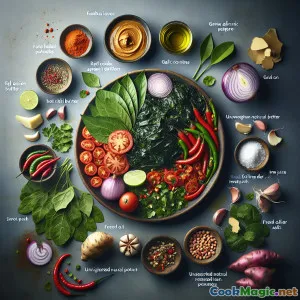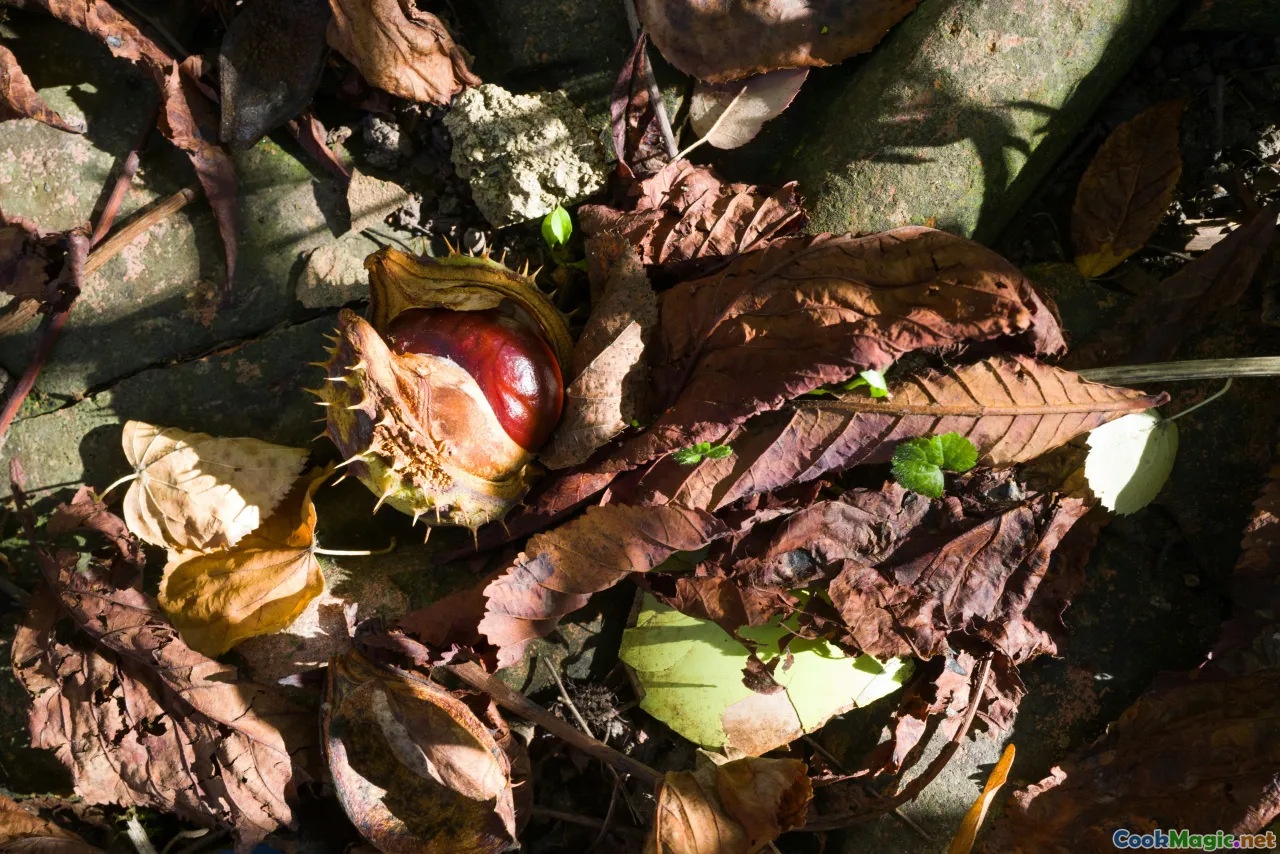
Aromatischer Fumbwa-Blatt-Teller mit Würziger Erdnusssauce
(Fumbwa Leafy Aromatic Platter with Spicy Peanut Sauce)
(0 Bewertungen)0
1,246
August 22, 2025
Problem melden
Zutaten
-
400 grams Fumbwa-Blätter (Gnetum africanum)
(Substitute with collard or spinach in a pinch.)
-
1 large Rote Zwiebel
(Thinly sliced for freshness.)
-
2 medium Tomaten
(Roma or heirloom for best flavor.)
-
3 pieces Knoblauchzehen
(Crushed or finely minced.)
-
1 tbsp Frischer Ingwer
(Zerkleinert.)
-
1 small Chilipeper
(Remove seeds for mild heat.)
-
4 tbsp Erdnussbutter (ungesüßt, natürlich)
(Use smooth or chunky.)
-
3 tbsp Pflanzenöl
(Palm oil for authenticity.)
-
300 grams Süßkartoffeln
(Cubed, for serving.)
-
100 grams Geräucherter Fisch
(Boneless, optional for vegan.)
-
1 tsp Salz
(Nach Geschmack.)
-
1 tbsp Limettensaft
(Frisch gepresst für Helligkeit.)
-
2 tbsp Frischer Koriander (Kräuter)
( Fein gehackt, zum Garnieren.)
(Substitute with collard or spinach in a pinch.)
(Thinly sliced for freshness.)
(Roma or heirloom for best flavor.)
(Crushed or finely minced.)
(Zerkleinert.)
(Remove seeds for mild heat.)
(Use smooth or chunky.)
(Palm oil for authenticity.)
(Cubed, for serving.)
(Boneless, optional for vegan.)
(Nach Geschmack.)
(Frisch gepresst für Helligkeit.)
( Fein gehackt, zum Garnieren.)
Nährwerte
- Portionen: 4
- Portionsgröße: 1 platter (250g)
- Calories: 420 kcal
- Carbohydrates: 46 g
- Protein: 16 g
- Fat: 20 g
- Fiber: 8 g
- Sugar: 9 g
- Sodium: 740 mg
- Cholesterol: 12 mg
- Calcium: 136 mg
- Iron: 3.1 mg
Anweisungen
-
1 - Prepare the Fumbwa Leaves:
Rinse fumbwa leaves several times. If using dried, soak in warm water 15 minutes until softened. If using spinach/collard, trim stems and roughly chop.
-
2 - Cook Root Veggies:
Boil sweet potato cubes in salted water for 10 minutes until fork-tender. Drain and reserve for serving.
-
3 - Sauté Aromatics:
Heat oil in a broad pan. Gently sauté onions until translucent, then add garlic, ginger, and chili, stirring for another 2 minutes until fragrant.
-
4 - Simmer Fumbwa & Tomatoes:
Stir tomatoes into aromatics, cooking until soft. Add fumbwa leaves, 1 cup water, and smoked fish (if using). Cover and simmer for 10 minutes, stirring occasionally.
-
5 - Add Peanut Butter:
Spoon peanut butter into pan. Stir well to dissolve into sauce. Cook on low heat until sauce thickens and leaves are tender, about 7 minutes. Season with salt.
-
6 - Finish & Serve:
Remove from heat. Stir in lime juice, adjust seasoning, and transfer onto platter with sweet potatoes. Garnish with coriander. Serve warm.
Rinse fumbwa leaves several times. If using dried, soak in warm water 15 minutes until softened. If using spinach/collard, trim stems and roughly chop.
Boil sweet potato cubes in salted water for 10 minutes until fork-tender. Drain and reserve for serving.
Heat oil in a broad pan. Gently sauté onions until translucent, then add garlic, ginger, and chili, stirring for another 2 minutes until fragrant.
Stir tomatoes into aromatics, cooking until soft. Add fumbwa leaves, 1 cup water, and smoked fish (if using). Cover and simmer for 10 minutes, stirring occasionally.
Spoon peanut butter into pan. Stir well to dissolve into sauce. Cook on low heat until sauce thickens and leaves are tender, about 7 minutes. Season with salt.
Remove from heat. Stir in lime juice, adjust seasoning, and transfer onto platter with sweet potatoes. Garnish with coriander. Serve warm.
Mehr über: Aromatischer Fumbwa-Blatt-Teller mit Würziger Erdnusssauce
Fumbwa Leafy Aromatic Platter: Origins, Appeal and Culinary Notes
Fumbwa, or Gnetum africanum, is a unique leafy vegetable hailing from the forests and farmlands of Central Africa, most notably the Democratic Republic of the Congo and Cameroon. For many, this green is an ancient yet enduring symbol of home-cooked, nutrient-rich cuisine. Its lush flavor profile—somewhere between deep spinach and wild herbs—earns it a revered place in the Congolese culinary tradition and across the African continent.
A Celebration Dish with Depth
At family gatherings, special events, or communal suppers, a heaping platter of fumbwa usually occupies the table’s center. The leaves provide more than lush greenery: they are a showcase of foraged or market-sourced abundance, bringing fiber and vitamins to every spoonful. Integrating tomatoes, zesty ginger, creamy peanut sauce, and sometimes bits of smoked fish, this dish weaves textures and flavors into an unforgettable whole.
History & Cultural Significance
Traditionally, fumbwa is hand-chopped or pounded to soften fibrous strands, so when simmered, it yields both silkiness and depth. It is not just an earthy, satisfying dish—it reflects a philosophy of zero-waste and resilience. Whole families, especially women and children, participate in the preparation, which transforms even limited resources into soul-satisfying food.
In the DRC, this preparation’s popularity is a testament to fumbwa's hardy, adaptable character. The addition of smoked or dried fish reflects proximity to rivers or markets, but in larger towns this is sometimes left out, turning the platter vegan. The peanut sauce isn’t mere flavor: peanuts are a valued protein source, turning humble foraged leaves into a main feast.
Cooking Tips and Personal Insights
For anyone unable to get true fumbwa, while chopped spinach or collard greens provide a structural stand-in, one might add a handful of fresh dill or flat-leaf parsley to echo wild, resinous notes. Don’t shy away from using palm oil for tradition; just note its unique color and flavor.
This recipe’s steps always honor aromatics—a bedrock in much African cuisine. Letting ginger, garlic, and onion truly soften ensures layers of fragrance as the backdrop for leafy richness and peanut umami. Adjust the diesel-power of chili and lime according to taste and tolerance; fumbwa will absorb and mellow their sharpness beautifully.
Prep the sweet potatoes last: they’re a gentle, filling counterpoint to the dish’s herbal notes, and make this a nutritional powerhouse, offering slow carbs, protein, and foliage in equal measure.
Presentation & Variations
Traditionally, serve this dish warm, unlike chilled Western salads—it should curl fragrant steam from the platter. Garnish with coriander if you like, or serve with grilled plantains for the full feast. You can serve on its own or pair with other staple sides like cassava fufu, boiled yams, or rice.
Vegetarian and vegan cooks can happily skip smoked fish; a dash of smoked paprika can add a similar honest depth. Advanced cooks might pulse rehydrated dried mushrooms with the greens for even more texture.
Final Thoughts
A platter of fumbwa brings you close to the heart of Congolese hospitality: colorful, warm, humble, yet worthy of a celebration. Every forkful is wellness—rooted, sustainable, vibrant. For those curious or nostalgic, the aromas conjured during cooking will underscore why leafy greens endure as some of the world’s most revered foods. Experiment, share, and enjoy every bite—your kitchen, for today, is an embassy of Africa.




















